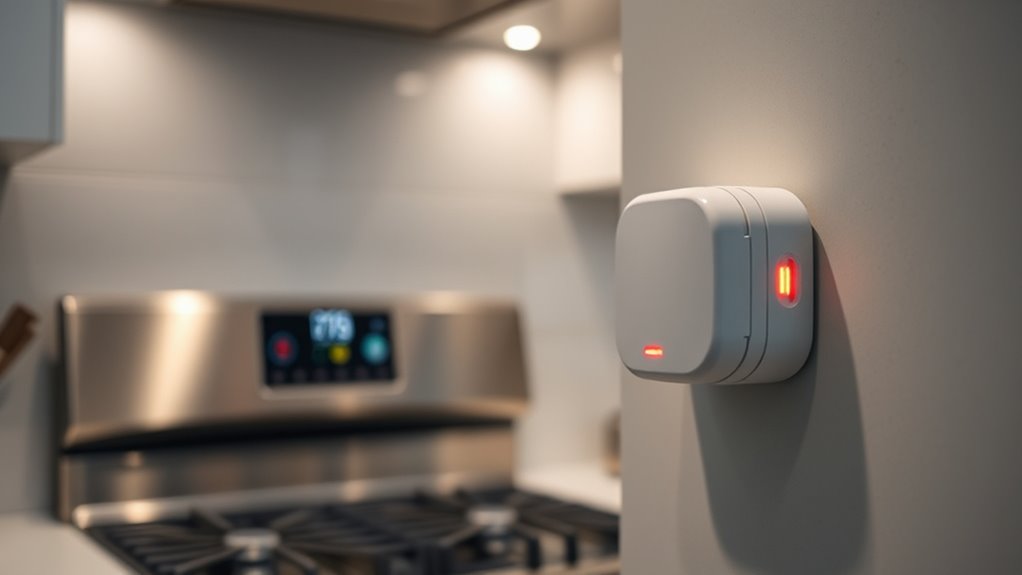To prevent fires with auto shut-off devices, you should guarantee they are properly installed, maintained, and regularly tested. These safety tools automatically cut power during overheating or electrical surges, reducing fire risks. Keep sensors clean, update firmware, and replace batteries as needed. Remember, maintenance and vigilance are key to effectiveness. Want to discover more ways auto shut-off devices can protect your home and workplace? Stay tuned for helpful insights.
Key Takeaways
- Regularly test and maintain auto shut-off sensors to ensure quick response during overheating or electrical faults.
- Keep sensors and switches clean and free of dust or debris to prevent malfunction.
- Follow manufacturer guidelines for updates and proper maintenance to extend device lifespan.
- Combine auto shut-off devices with good fire safety practices, like avoiding circuit overloads and flammable materials.
- Keep detailed records of inspections and servicing to ensure ongoing effectiveness and compliance.

Auto shut-off devices are safety features designed to automatically turn off appliances or equipment when they detect issues such as overheating, power surges, or inactivity. These devices serve as a crucial line of defense in fire safety, helping prevent potential fires caused by electrical malfunctions or unattended appliances. When you install or use equipment equipped with auto shut-off technology, you’re taking proactive steps to reduce fire hazards in your home or workplace. The key to maximizing their effectiveness lies in proper device maintenance. Regularly inspecting these devices ensures they function correctly when needed most.
Maintaining auto shut-off devices is straightforward but essential. You should periodically check that the sensors and switches are clean and free of dust, debris, or corrosion that could impair their performance. For example, if your smoke or heat detectors are connected to auto shut-off systems, ensure they are tested monthly to confirm they trigger alarms and shut-off mechanisms as intended. Replacing batteries and testing the circuitry keeps everything in working order, so the device can respond instantly during an emergency. When devices are not properly maintained, they may fail to activate during critical moments, increasing the risk of fire. Additionally, understanding the specific triggers these devices respond to can help in customizing maintenance routines for optimal safety.
Regularly test and clean auto shut-off sensors to ensure they operate effectively during emergencies.
Using auto shut-off devices also involves understanding their limitations. They are designed to respond to specific triggers like overheating or power surges, but they don’t replace good fire safety practices. You should still avoid overloading circuits, keep flammable materials away from heat sources, and stay vigilant with fire safety protocols. The devices act as an extra safeguard, but your awareness and responsible usage are equally important. Proper device maintenance ensures that these safety features work seamlessly when needed, giving you peace of mind.
In addition to regular checks, keep up with manufacturer recommendations for maintenance and updates. Sometimes, firmware or software updates are necessary to keep auto shut-off systems functioning at their best. Maintaining documentation of inspections and servicing can help you stay organized and ensure compliance with safety standards. When you prioritize device maintenance, you extend the lifespan of your safety equipment and reinforce your fire safety measures.
Ultimately, auto shut-off devices are an effective tool in fire prevention, but they require your attention. By routinely inspecting, testing, and updating these devices, you enhance their reliability and your overall safety. Remember, fire safety isn’t just about having the right equipment—it’s about maintaining it properly so it can serve its purpose when it counts most. With diligent device maintenance, you considerably reduce the risk of fires caused by electrical faults, giving you greater confidence in your safety measures. Keeping your devices in top condition is especially important given that modern electrical appliances can malfunction unexpectedly, increasing the importance of regular maintenance.
Frequently Asked Questions
How Do Auto Shut-Off Devices Detect Fire Hazards?
Auto shut-off devices detect fire hazards through advanced fire detection and hazard sensors. These sensors monitor heat, smoke, or flames, triggering an alert when they sense dangerous conditions. You’ll notice that they respond quickly to changes, automatically shutting off appliances or power sources to prevent fires. By constantly monitoring for signs of danger, these devices help keep your home safe and reduce fire risks effectively.
Are Auto Shut-Off Devices Compatible With Smart Home Systems?
Is your home ready to embrace the future? Many auto shut-off devices now feature smart home integration, making device compatibility seamless. You can easily connect them to your existing smart systems, allowing you to monitor and control fire prevention measures remotely. This integration not only enhances safety but also simplifies your life. So, rest assured, auto shut-off devices are becoming increasingly compatible with smart home systems for smarter, safer living.
What Maintenance Is Required for Auto Shut-Off Fire Preventers?
To keep your auto shut-off fire preventers working effectively, you need regular fire extinguisher inspections and sensor calibration. Check for any damage or corrosion and make certain sensors are clean and functioning correctly. Schedule professional inspections annually and test sensors periodically to confirm proper operation. Proper maintenance helps prevent malfunctions, ensuring your device activates immediately during a fire, keeping your home safe.
How Long Does It Take for an Auto Shut-Off Device to Activate?
This question hits like lightning—how quickly does an auto shut-off device activate? In fire safety, every second counts, and most devices respond within seconds, often in less than a blink of an eye. Once the heat reaches the trigger point, the device activates immediately to shut off fuel or electricity, preventing fires from spreading. You can rely on these systems to protect lives and property with rapid, automatic device activation.
Can Auto Shut-Off Devices Prevent All Types of Fires?
You might think auto shut-off devices prevent all fires, but fire safety myths can be misleading. These devices help reduce risks, yet they have limitations and can’t prevent every type of fire. For example, they may not activate quickly enough for certain flames or electrical faults. Knowing auto shut-off limitations guarantees you don’t rely solely on them. Always combine these devices with proper safety practices for the best fire prevention strategy.
Conclusion
Think of auto shut-off devices as vigilant guardians watching over your home’s flame. They symbolize peace of mind, silently stepping in when danger looms, much like a steady hand guiding you away from harm. By embracing this simple yet powerful technology, you’re not just preventing fires—you’re illuminating a safer path forward. Let these devices be the lighthouse in your home’s harbor, guiding you safely through every moment, and ensuring safety becomes your unwavering beacon.









